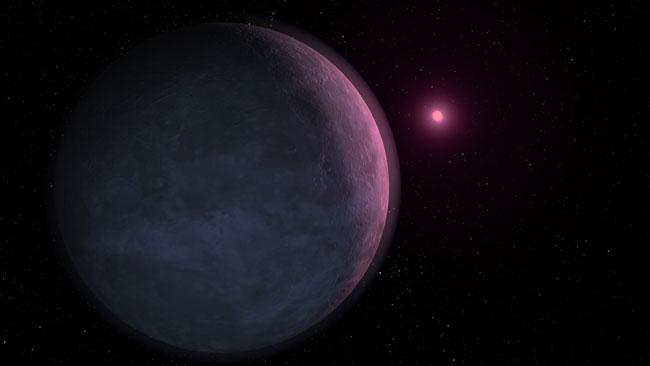New Mini-Planet Is Lightweight Champ

ST. LOUIS ? There's a new extrasolar planeton the block: a mini-orb likely covered with a deep ocean. And it takes therecord for the lowest mass exoplanet to orbit a normal star, astrophysicistsannounced today.
The li'lplanet ? weighing in at three times Earth's mass ?? grabsthe lightweight title from a five Earth-mass planet just announced inApril.
Thesuper-Earth is called MOA-2007-BLG-192Lb, after its host starMOA-2007-BLG-192L, which is located about 3,000 light-years from Earth. (Alight-year is the distance light travels in one year, or about 5.88 trillionmiles ? 9.46 trillion kilometers.)
The hoststar's mass is estimated to be roughly 6 percent ofthe sun's mass, or just below the mass needed to sustain nuclear reactions inits core, thus making it a brown dwarf. Measurement uncertainty means the host masscould be slightly above 8 percent of a solar mass, which would make MOA-2007-BLG-192L avery low-mass hydrogen-burning star. The researchers suspect the star is indeed a brown dwarf.
"Ourdiscovery indicates that that even the lowest mass stars can hostplanets," said lead researcher David Bennett of the University of NotreDame. "No planets have previously been found to orbit stars with massesless than about 20 percent of that of the sun, but this finding suggests thatwe should expect very low-mass stars near the sun to have planets with a masssimilar to that of the Earth."
Bennettannounced the discovery here at a meeting of the American Astronomical Society(AAS).
The planetorbits its host star at about the same distance as Venus orbits the sun. Butthe new planet's host star is likely between 3,000 and 1 million times fainterthan the sun, so the top of the planet's atmosphere is probably colder thanPluto.
Get the Space.com Newsletter
Breaking space news, the latest updates on rocket launches, skywatching events and more!
Theastrophysicists suggest the tiny planet supports a thick atmosphere,which along with possible interior heating by radioactive decay, could make thesurface as balmy as that of Earth. (And theory suggests the surface may becompletely covered by a deep ocean.)
Thestar-planet system was found using a technique called gravitationalmicrolensing, in which light from the planet is bent and magnified by thegravity of a foreground object, such as a star. It marks the seventh planet to date discovered using this method.
"This discovery demonstrates the sensitivity of the microlensing method for finding low-mass planets, and we are hoping to discover the first Earth-mass planet in the near future," Bennett said.
Most of the nearly 300 exoplanets identified to date have been discovered using the radial velocity method in which astronomers look for slight wobbles in a star's motion due to the gravitational tug of an orbiting planet. This stellar wobble technique has found mainly large, Jupiter-like planets or smaller planets that orbit too close to their host stars to harbor life.
The research, funded by the National Science Foundation and NASA, will be detailed in the Sept. 1 issue of Astrophysical Journal.
- Video: Planet Hunter
- Top 10 Most Intriguing Extrasolar Planets
- All About Planets
Join our Space Forums to keep talking space on the latest missions, night sky and more! And if you have a news tip, correction or comment, let us know at: community@space.com.










